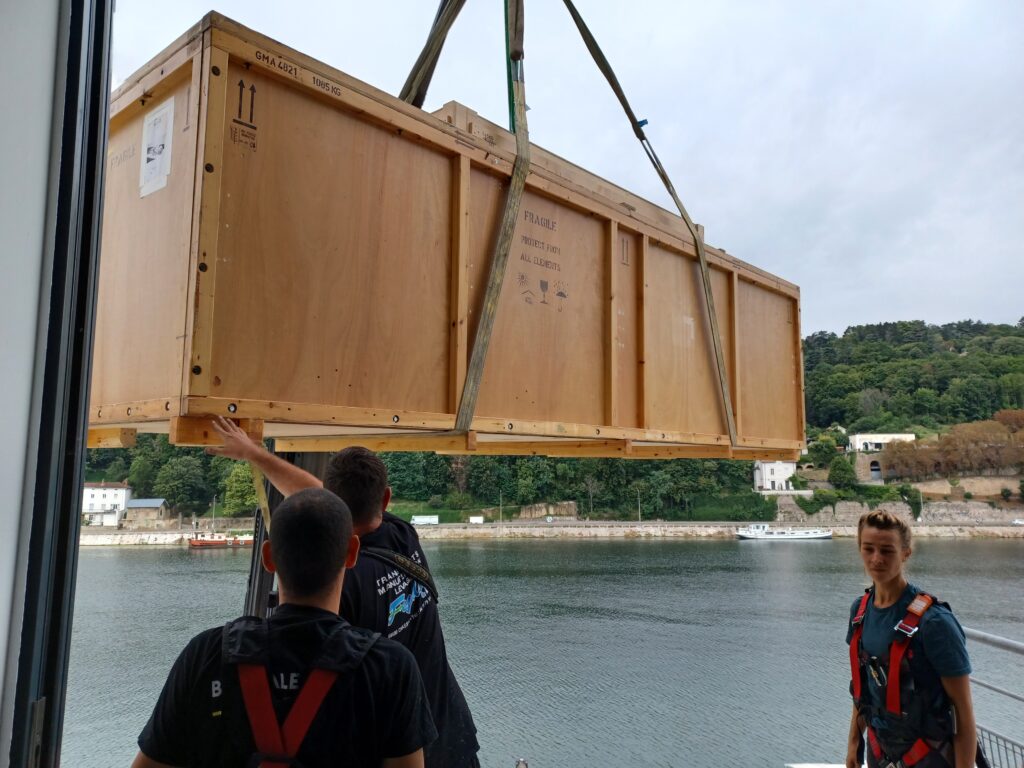ERC2022, 4th November 2022: Two women and a baby – large sculpture moves
Jacqui Austin, National Galleries of Scotland, Edinburgh & Lena Pohlmann, Institute for Cultural Exchange, Tubingen, Germany
This insightful session was part of the Global Museum strand of ERC2022, held in Strasbourg. The ‘two women’ of the presentation’s title were speakers Jacqui Austin (National Galleries of Scotland, Edinburgh) & Lena Pohlmann (Institute for Cultural Exchange, Tubingen, Germany), and the ‘baby’ they had been contending with was Australian artist Ron Mueck’s A Girl (2006) – an enormous, hyperreal sculpture of a new-born baby girl, that sits on a large bespoke plinth.
At just over 5 metres in length, and housed in a crate that is 5.5 metres long, A Girl is one of the largest sculptures in the National Galleries of Scotland (NGS)’s collection. Due to its size and fragility, any movements of this work have historically always required the oversight of a physical courier. Since 2018, A Girl has been included in ‘Reshaped Reality: 50 Years of Hyperrealistic Sculpture’, an international touring exhibition organised by Institute for Cultural Exchange. The show was on display at La Boverie in Liège, Belgium, in 2020 when the Covid-19 pandemic hit and forced the sector to consider new ways of working.
The exhibition in Liège was extended due to Covid lockdown-related closure, and A Girl was eventually deinstalled in August 2020 using a virtual, rather than an in-person, courier for the first time. From there it travelled to Hagen in Germany where it was installed, and deinstalled in April 2021, again using virtual couriers due to Covid restrictions and related organisational policies. We heard from the speakers about the importance of planning ahead carefully for virtual couriering of installs and deinstalls. Agreement between all parties of which parts of the process needed to be overseen was key, considering where the risk lies at each stage. The two speakers remarked on just how much they had been in communication during this time, and how beneficial that was to the project.
The next tour venue was in Brussels, Belgium, opening in June 2021. Quarantine restrictions meant that sending a physical courier was still not possible, and so a virtual courier was again used for this install. However as it had been 18 months at this point since the artwork had left NGS stores, a local conservator was also engaged to carry out a full condition-check of the work. After another virtual deinstall, the work travelled to La Sucrière in Lyon, France, where the exhibition opened in February 2022. The access to this venue’s exhibition space was complex, requiring the crate to be craned in through a top-floor window. For this reason, and as Covid and organisational restrictions now permitted, NGS sent a physical courier to oversee both install and deinstall, having successfully managed the work’s display at three venues remotely.
One of the key takeaways from this session was how a dramatic change in circumstances had driven a general rethink of what is ‘necessary’; doing so meant that things suddenly became possible that wouldn’t have been considered previously. In 2022, NGS had reduced its use of couriers by around 75% compared to 2019 (though this is coupled with a significant reduction in the number of loans). The benefits include a reduction in carbon footprint, and less overall use of staff resources, although it was noted that virtual couriering does mean more work for loans registrars. It was noted that virtual couriers still need appropriate training, and sometimes, as with the exhibition in Lyon, a physical courier cannot be substituted. NGS’s current approach is to consider the risks associated with each artwork and situation on a case-by-case basis, with the open mindedness precipitated by the pandemic.
Denise Courcoux, Exhibitions Registrar and Production Manager (maternity cover), Tate Liverpool


 Instagram
Instagram  LinkedIn
LinkedIn  Twitter
Twitter  My Account
My Account